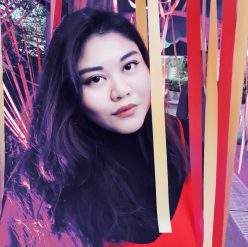The term “Uncomfortable Interactions” came about by Steve Benford and his team of creatives and innovators. Steve Benford is a professor of Collaborative Computing in the Mixed Reality Laboratory at Nottingham where he explores future cultural and entertainment technologies. Uncomfortable Interactions stems from experimenting and pushing the limits and possible outcomes of HCI which stands for human-computer interaction[1]. HCI researches the design and use of computer technology, focused on the “user-friendly” expect of an interface. HCI’s engagement with cultural experiences such as art installations, performances, guides and games has inspired some unconventional approaches that usually comes only in traditional interactional designs[2].
Professor Steve Benford giving a lecture on Uncomfortable Interactions at the University of Salford, Manchester.
Uncomfortable interactions are said to benefit cultural experiences in three methods which are entertainment, enlightenment and sociality. Entertainment can be one of the ways of uncomfortable interactions through firstly, physical discomfort. This can take the form of riding roller-coasters or doing extreme sports such as bungee jumping as it evokes a feeling of thrill by a combination of fearful anticipation, followed by an extreme physical sensation, and then the euphoria of relief at having survived[3].
Enlightenment through interpretation can also be one of the ways of uncomfortable interactions as it tends to provoke interpretation rather than directly giving information to the audiences. This is achieved by including a certain ‘ambiguity of relationship’[4] in which the participant’s relationship to the experience becomes subject to interpretation.
Lastly, sociality is also one of the ways of uncomfortable interactions as it allows for confronting and sharing discomfort as a form of social bonding. This same principle can be applied to team building activities whereby groups would have to endure and go through challenging tasks together[5]. Social bonding around discomfort extends to audiences as they witness the public discomfort of others.

These ideas are exemplified through the game, Uncle Roy All Around You where the uncomfortable interactions could come in the forms of Discomfort through Control and Discomfort through Intimacy. For the online players, they are giving up their control to a bot called “Uncle Roy” in which it would be giving the online players directions in order to guide the street players to Uncle Roy’s office. This continues as a chain where street players surrender their control over to the online players in which giving the online players full control of telling them where to head to in order to find Uncle Roy’s office.
Discomfort through Intimacy can also be seen in the game as it allows the online players a chance to see their street players through surveillance camera as soon as they reach Uncle Roy’s office. This is also the moment whereby they will be deciding if they would want to commit to the commitment of staying with each other for the next 12 months.

Uncle Roy All Around You’s possible benefits would be Entertainment and Enlightenment. I believe that this game benefits entertainment wise for the Street Players in particular is because throughout the 60 minutes they are given, they are constantly being put on edge and the suspense of waiting for the next directions, getting into Uncle Roy’s office and also meeting Uncle Roy himself.
The game benefits enlightenment wise as there is a great sense of ambiguity that occurs between the participants’ relationship to the experience.This is because the players are being placed in a position whereby the online players are able to control the directions given to the street players meaning they can easily led them to the wrong way. However, subconsciously or not, the players still do realize how it is indeed after all a game or a piece of artwork that is being carefully orchestrated by the game’s orchestration team comprising of 10 people.
References:
[1] Rouse, Margaret. “HCI (human-computer interaction).” SearchSoftwareQuality. https://searchsoftwarequality.techtarget.com/definition/HCI-human-computer-interaction (retrieved 25 February 2019)
[2] Benford, Steve. “Uncomfortable Interactions.” Session: Culture, Playfulness, & Creativity. (2012) Pg. 2005
[3] Benford, Steve. “Uncomfortable Interactions.” Session: Culture, Playfulness, & Creativity. (2012) Pg. 2006
[4] Benford, Steve. “Uncomfortable Interactions.” Session: Culture, Playfulness, & Creativity. (2012) Pg. 2006
[5] Benford, Steve. “Uncomfortable Interactions.” Session: Culture, Playfulness, & Creativity. (2012) Pg. 2006


























